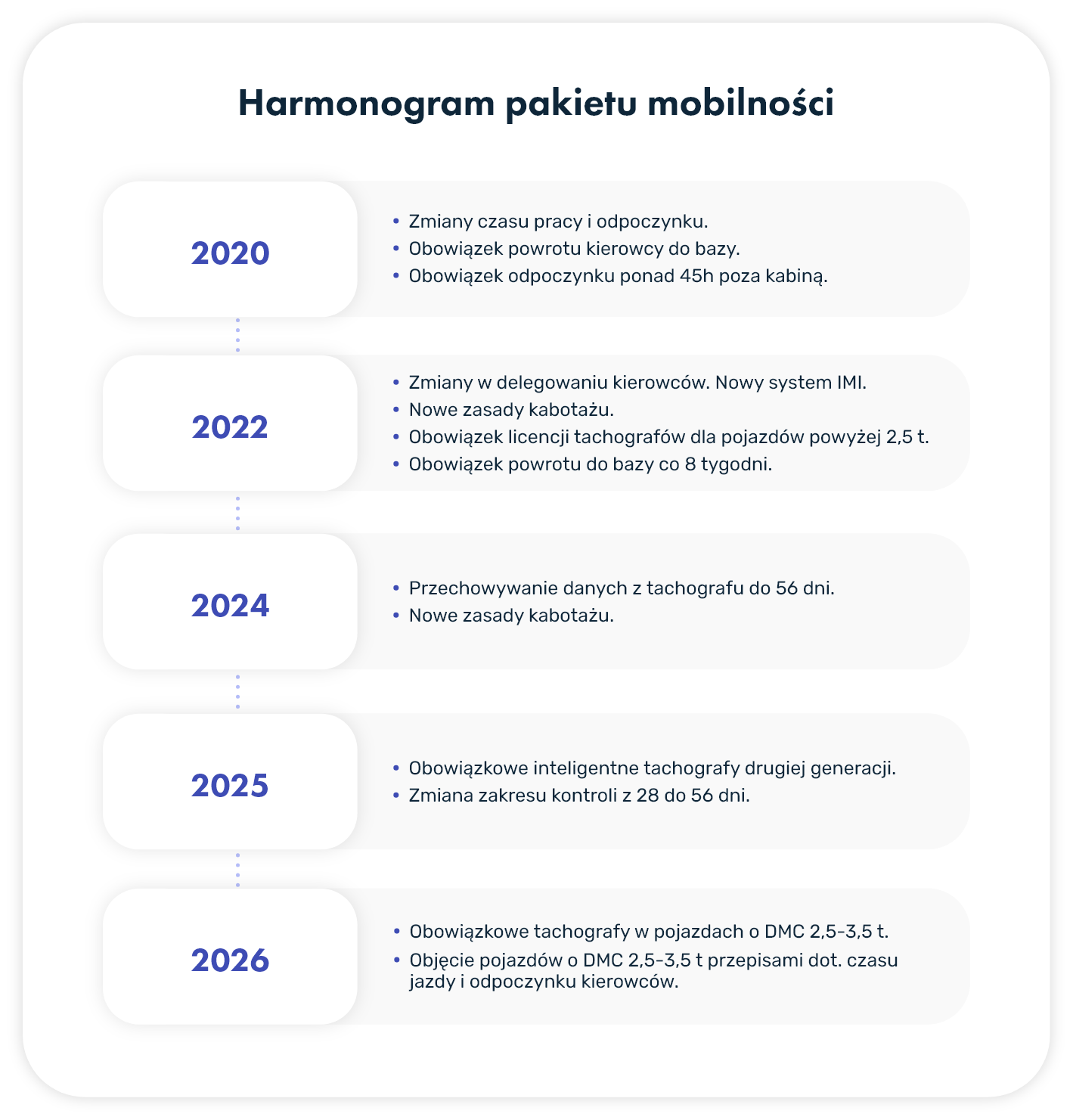EU mobility package – where did it come from?
The origins of what we know today as the mobility package can be traced to two documents. We are talking about the minimum wage laws introduced in Germany and France:
MILOG, or Gesetz zur Regelung eines allgemeinen Mindestlohns
This is a law that, although passed in the German parliament, also affected Polish transport companies operating in the country of our western neighbors.
According to the provisions of the document, which came into force on January 1, 2015, any person working in Germany is entitled to receive a salary no lower than the rate set by law. As of October 2022, it is €12 per hour (a minimum of €2,016 per month with full-time employment).
There would be nothing surprising in the introduction of the minimum wage itself, but there was a provision in the MILOG law that sparked widespread discussion – the Bundestag decided that employers from other countries must also provide a German minimum wage to their personnel providing work in Germany.
The entry into force of the MILOG law changed the situation for many Polish entrepreneurs operating in the transport industry and, as it turned out, was a prelude to much more far-reaching changes.
Important!
The MILOG law is controversial not only because of the provisions themselves, but also through problems with compliance and enforcement. Courts in Germany have repeatedly issued inaccurate or contradictory rulings.
This led to situations in which Polish companies operating in the transport industry were unsure for months how to act properly, and eagerly awaited the resolution of German customs inspections carried out on Polish entrepreneurs also operating in Germany.
Loi Macron
The second of the pioneering pieces of legislation in Western Europe was the law often referred to as Loi Macron. Decree No. 2016-418 went into effect almost exactly 1.5 years after the MILOG law, on July 1, 2016.
The main premise of Loi Macron is almost identical to its German counterpart – the introduction of a minimum wage affecting French entrepreneurs equally, as well as companies from other countries that employ people working in France.
Loi Macron, in addition to designating a number of new obligations and setting penalties for non-compliance, introduced one additional burden for entrepreneurs – it required them to appoint a representative to represent the company in its dealings with authorities on the French side.
Mobility package for drivers?
The introduction of wide-ranging regulations for the transportation market throughout the European Union is intended to meet several objectives:
- ensure safety and better working conditions for drivers,
- bring the realities of the transportation market in line with the principles of social justice,
- act in the name of sustainable economic development,
- take care of the needs of all EU member states and level the playing field.
Have the initial assumptions been met? It’s hard to judge. However, it is important to keep in mind that although the mobility package was launched in 2020, the regulations are not expected to receive their final form until 2026 – by which time more and more changes will be gradually introduced.

Mobility package – first phase of changes (2020 regulations)
With its entry into force, the mobility package has introduced regulations on several aspects of international drivers. They were:
- driving time,
- breaks while driving,
- returns to base,
- weekly rest.
Driving time
Strict regulations on maximum driving time per day have been loosened somewhat in 2020, but only under certain circumstances:
- working time may be extended by a maximum of one hour by the driver, when the driver was able to thus reach the base or residence to take weekly rest,
- driving time may be extended by no more than two hours (with the application of a half-hour break) if the driver can consequently reach the base or residence for a regular weekly rest.
Breaks while driving
In the context of work breaks, the mobility package introduced the possibility of taking a 45-minute rest while driving in a situation where another member of a multi-person crew is driving the vehicle.
Returns to base
According to the Mobility Package regulations, the driver’s work must be scheduled in such a way that the employee can take a regular weekly rest every four weeks at the base or place of residence. Drivers are entitled to base camp after taking two shortened weekly rests.
Weekly rest
International transport drivers are entitled to restorative rest. Under the new regulations, a driver can take two shortened weekly rest periods in a row (not less than 24 hours). The condition for taking shortened rest periods is to receive compensation in the form of a rest of equivalent duration, which the driver will use once no later than three weeks after taking the shortened rest.
What’s more, the mobility package introduced a ban on taking regular weekly rests in the cab of a vehicle – drivers are to be provided with a place to stay overnight.
Mobility package 2022 – second phase of changes
In February and May 2022, the next phases of the mobility package went into effect. What changes have occurred in them? This time, the European Parliament took the following issues to task:
- wages for drivers posted outside their home country,
- cabotage transports,
- definition of transportation company base,
- reporting of international transport drivers to the IMI system,
- changes regarding the operation and functioning of tachographs,
- vehicles over 2.5t GVW (permissible total weight).
Wages for posted workers
The changes initiated by the MILOG and Loi Macron laws mentioned in the first part of this article were not transplanted throughout the European Union until 2022.
International transport drivers should be paid for the portion of work they perform in the country at least equal to the minimum wage for transport workers in that country.
This means that Polish drivers who go with transport to Germany or Spain will be paid at least the national minimum wage in Germany, Spain or any other EU country where they provide work.
Important!
The rules on the wages of posted drivers apply to cabotage and cross trade – they do not apply to transit or bilateral transport.
Cabotage operations
Drivers performing cabotage operations must go to a base at least once every eight weeks, but it must be in the country where the company is based.
A limit has also been imposed on the number of cabotage trips that can be made by a single vehicle – currently there can be a maximum of three cabotage trips within 7 days within a single EU member state.
Important!
If an entrepreneur has several operating bases, they must collectively have the required number of parking spaces.
IMI System
Starting in 2022, companies operating in the transportation industry are required to report drivers performing cabotage and cross trade operations to the IMI system (Internal Market Information Exchange System). Drivers performing work in EU member states should carry a copy of the notification containing the QR code in case of an inspection.
Tachographs
Another element has been added to tachograph operation: international transport drivers are required to make entries in their tachographs that include the symbol of the country whose border they have just crossed. Such an entry should be made at the next stop.
Starting as early as 2023, transport companies must begin the process of replacing their current equipment with higher-generation tachographs – these will make the relevant entries automatically, without the driver’s involvement. According to the current plan for implementing the changes in the mobility package, mandatory replacement of tachographs is scheduled to begin in August 2025. We write more about these changes below.
Vehicles with GVW over 2.5 t
The 2022 set of amendments expanded the Mobility Package rules – from now on, carriers using vehicles with a GVW of more than 2.5t (rather than 3.5t as before) in their work are subject to cabotage rules. Moreover, they must obtain a license and meet the conditions of the road transportation profession.
Such a company must also financially secure the vehicles performing the transports. The amount of collateral for the first car of the fleet is €1,800. Each additional vehicle must be secured with an amount of min. EUR 900.
Mobility package 2023 – the third stage of changes
Although the original plans for the phased implementation of the mobility package in Europe did not figure in any significant changes for 2023, the plans have been modified over time. One of the reasons for the new approach was the need to align national laws with the mobility package so that the various provisions in Polish laws and EU regulations are not mutually exclusive.
2023 will see changes in three areas regarding the mobility package. The new and updated regulations specifically addressed:
- operating bases,
- mandatory statements,
- new tachographs,
- salary changes.
Parking bases with a minimum number of places
This change takes effect in January 2023, although it was originally scheduled to take effect as late as 2022.
Since then, regulations have required that operating bases be located on Polish territory. What’s more, they should be equipped to enable them to conduct business in a continuous and organized manner. The list of requirements for operating bases also included parking spaces, an unloading and loading area, and a maintenance and repair area.
The regulations don’t leave much to chance – operating bases must, starting in 2023, have a number of parking spaces of no less than ⅓ of the vehicles in the fleet – regardless of the number of bases.
Important!
If an entrepreneur has several operating bases, they must collectively have the required number of parking spaces.
New mandatory declarations for drivers
This change is also effective from January 2023.
Transportation companies are required to submit two new statements. This obligation is cyclical – carriers will have to remember it every year. The deadline for both statements is March 31.
Statement of the number of people employed. The carrier should submit this statement, also taking into account employees employed as of December 31 of the year preceding the obligation to submit the information. When making a statement about the number of employees at the beginning of 2025, it is therefore necessary to take into account the status at the end of 2024, regardless of when you make the statement.
Statement of the arithmetic average number of drivers employed. It is worth noting that the form of employment is irrelevant in this statement – it should include the average number of all drivers performing transport operations in the year preceding the time of filing the statement.
Replacement of tachographs with second-generation devices
The change is effective from August 21, 2023.
As of August 2023, every newly registered vehicle with a GVW of more than 3.5t should be equipped with a second-generation smart tachograph (G2V2). Today, the regulations have already been updated, and will take their final shape in 2026 – second-generation tachographs are to be installed in older and lighter vehicles as well.
- In August 2023, the first phase of the changes (installation of new-generation tachographs in new vehicles) was launched.
- In December 2024, the process of replacing analog and digital tachographs in older vehicles began, and mandatory storage of tachograph data for up to 56 days for inspection purposes was implemented.
- In September 2025, second-generation tachographs are to be present in every vehicle with a GVW of more than 3.5t.
- In July 2026, the obligation to equip a vehicle with second-generation smart tachographs will also extend to vehicles with a GVW of 2.5-3.5t (provided they are used for international transport).
Changes in the salaries of international transport drivers
These changes went into effect in August 2023.
The new rules on the posting of drivers in road transport were intended to facilitate the alignment of laws in individual EU countries with those set by the community. On August 19, 2023, the law of July 28, 2023 became effective. On the posting of drivers in road transport. The law on drivers’ working time has also been modified. The latter clarifies the issue of business travel. One of the most important provisions that has been updated is the one proclaiming that “a driver performing business tasks in international road transport is not on a business trip” within the meaning of the Labor Code.
The new entries in the Drivers’ Hours Act also introduce the concept of average wages. It is intended to establish a criterion for determining dues for professional drivers. The updated entry can be found Article 2. Item 8 of the same.
Under the new regulations, the issue of determining the tax base for drivers involved in international transportation has also been changed. Art. 26f para. 2 of the Law on Working Time of Drivers says that in their case the regulations issued under Art. 21 of the Law of October 13, 1998. on the social insurance system concerning employees working abroad for Polish employers.
Moreover, Art. 26g of the Law (on drivers’ working time) contains additional rules, covering those drivers whose monthly income exceeds the value of the average salary (determined in accordance with the rules cited above). In such cases, income does not count:
- an amount equivalent to 60 euros for each day of stay abroad, with the proviso that the monthly income of such persons constituting the basis for assessment of contributions, so determined, may not be lower than the amount of the average salary.
- dues representing reimbursement of the equivalent of the driver’s expenses, among others. overnight accommodation, travel to the place of commencement by means of transportation not at the employer’s disposal, necessary documented expenses or use of sanitary facilities at places of business.
For each day of stay abroad in the performance of international transport, the driver receives a uniform per diem rate of 60 euros. This is the result of a simplification, since until now the amount of per diems varied depending on which country the driver was in.
Example:
Mr. Karol performs international transportation for his employer by land. His monthly income is PLN 9,200 – so it exceeds the average salary (currently PLN 7,768.35).
To calculate the Social Security contribution base for a driver, the total amount of per diems he received while performing his duties must be subtracted from his earnings. Mr. Karol stayed abroad for 8 days, and therefore received an allowance of 480 euros. At the current exchange rate of PLN 4.29, this means that the per diems, converted into zlotys, amount to PLN 2,059.20. We subtract this amount from the driver’s monthly income:
PLN 9,200 – PLN 2,059.20 = PLN 7,140.80. The amount obtained does not exceed the value of the average salary, which means that for the purpose of determining the tax base, it is the value of the average salary, which is currently PLN 7,768.35, that is taken.
A few more important changes are worth mentioning:
- The days of stay abroad referred to in the Law on Drivers’ Hours of Work and the PIT Law do not include days during which the driver took annual leave, unpaid leave or was on sick leave.
- If a driver stays abroad for less than 12 hours in a day, he receives a correspondingly smaller allowance – ½ of the amount when the stay is between 8 and 12 hours, ⅓ of the amount when the stay is less than 8 hours.
- Income from an employment relationship and a contract of mandate is exempt from income tax in the amount of 20 euros for each day of a driver’s stay outside the country when performing business tasks.
Mobility package 2024 and 2025 – current status and upcoming changes
On the last day of last year, the mobility package underwent another transformation. On December 31, 2024, another set of new rules went into effect. One of them changed the scope of on-road inspections, while another increased the pool of vehicles required to have second-generation smart tachographs.
Extended scope of control on the road
In a situation where a driver is subjected to a roadside check, he is now required to produce tachograph data covering the last 56 days. This is a powerful change – until now the period was 28 days.
An important aspect of the change is that it applies not only to drivers of vehicles equipped with modern tachographs, but also to those who previously used analog devices and drivers exempted from tachograph use.
If the vehicle is equipped with an analog tachograph, the driver must present record sheets and/or handwritten records for the last 56 days during the inspection. If the vehicle is equipped with a digital device, tachograph printouts covering the requested period must be presented to the inspectors. On the other hand, drivers who are not required to use tachographs should have a work schedule prepared – in this case, too, the 56-day inspection period applies.
In case of technical problems or other impediments preventing the presentation of the required printouts during the inspection, the driver has the right to contact the transport company he represents to obtain the missing data.
Smart tachographs in older vehicles
The current tachograph standard in operation is second-generation smart devices (G2V2). In 2025, these devices should be installed in vehicles that meet the following conditions:
- perform international transportation,
- do not have a fourth-generation tachograph.
The criteria therefore include vehicles equipped with G1 tachographs, manufactured between 2006 and 2019.
The next stage of tachograph replacement
As part of the ongoing standardization, further changes are planned for the installation of G2V2 tachographs. On August 20, 2025, it becomes mandatory to install second-generation smart tachographs (G2V2) in vehicles that were previously equipped with first-generation smart tachographs (G2V1).
Mobility package 2026 – the final stage of change
Further updates to the regulations under the mobility package – as we now know, this will be the final set of changes – are planned for June 2026. This is when G2V2 tachographs are expected to become mandatory for all vehicles with a gross vehicle weight of 2.5t to 3.5t operating in international transport.
At the same time, all of these vehicles will be covered by the rules in the regulations:
- No. 165/2014 on tachographs used in road transport.
- No. 561/2006 on driving time, breaks and rest periods,
Mobility package – examples of penalties
The new regulations also include information on penalties and fines that are imposed on carriers and drivers who do not comply with the package’s rules. Here are some of them:
Example penalties for drivers
- Lack of entry to a new country in the tachograph – PLN 100,
- Driving without a tachograph – PLN 1,000,
- Weekly rest in the cabin of the vehicle or in a place not intended for it – PLN 50 (the same fine will also be paid by the carrier and the person managing the transport),
- Lack of an extract from the permit to practice the occupation of road transport operator – PLN 200,
- Lack of driver’s certificate – PLN 150,
- Lack of records and printouts from the tachograph for each day subject to inspection – PLN 200
- Lack of a chart for the day subject to inspection – PLN 500,
- In the event that 2 to 15 charts are missing – PLN 1,000/day,
- In the event that more than 15 charts are missing – PLN 1,500/day.
Examples of penalties for carriers
- Lack of documentation for international carriage (lack of waybills, declaration of posting, etc.) – a penalty of PLN 3,000 will be paid by the carrier,
- Performing carriage without the required permits (including a permit to perform the occupation of road carrier) or licenses – PLN 12,000,
- Making the driver’s remuneration dependent on the number of kilometers driven, the speed of delivery or the amount of cargo transported – PLN 8,000 per driver,
- Failure to keep or improperly keep employee records – PLN 1,000,
- Falsification of an employee’s records or refusal to provide such records – PLN 8,000.
Summary
The mobility package has already been in place since 2020, and all indications are that with 2026 the final modifications to EU law will be implemented – as planned. This large and ambitious undertaking will already come to an end next year.
This does not, of course, mean the end of work on regulating drivers’ working conditions or improving safety on the European Union’s roads. Entrepreneurs and drivers should still remain vigilant about planned and implemented changes in the law. Failure to comply with them risks severe financial penalties. However, if your company keeps up to date with the changes, a longer breather is in store after 2026 – at least with regard to the regulations covered by the mobility package.


